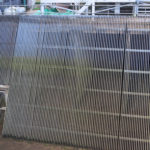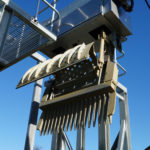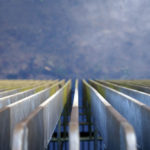Correct design & installation of trash screens eases flood risk
Trash screens form a crucial part of the infrastructure designed to reduce the risk of flooding in waterways and water processing sites. With considerable resources being employed in flood defence mechanisms to help protect property and maintain proper drainage across the country the performance of a humble trash screen is becoming increasingly important. Where a watercourse flows through a culvert there is an increased risk of blockage, requiring careful design consideration to ensure the most efficient structure is installed.
A great deal of research has been carried out with regard to debris in watercourses and how to reduce its impact on the local environment. By understanding the seasonal variations, combined with the location, it is possible to assess the likely flood risk and therefore decide on the best course of action with regard to protecting culverts and drains from blocking.
A culvert represents a bottle-neck in a watercourse and often the installation of a trash screen will help to alleviate blockages, but the screen can also present a flood risk itself if it is not properly maintained and cleared regularly. The amount and type of debris that is captured by the screen is dependent upon the time of year and the location of the screen.
While it may seem obvious that screens are more likely to block during the winter months when there is more rain, combined with fallen leaves and other vegetation, research has also shown that specific local conditions and the type of land use are also major factors that need to be considered. These factors all have a bearing on the amount and type of debris that is deposited in the watercourse and therefore they also affect the risk of blockage and subsequent flooding.
Factors affecting design
Once the decision to install a screen has been made, proper design of the screen is essential in order to prevent it becoming a flood risk in itself. This design should include careful consideration for the bar spacing, screen angle and distance from the culvert entrance in addition to the clearance method and frequency.
Information gained about the location helps to determine the type and size of debris likely to accumulate at the screen and as the ratio of debris length to bar spacing increases, so does the risk of blockage. This can be combined with data relating to average flow rates, which also influence the risk of blockage.
The angle at which the screen is installed also affects the efficiency, with some screen bar angles in common use having been shown to block more frequently. Once the design of the screen is finalised, it is then necessary to assess the maintenance requirements of the screen, based on the debris loading and frequency of cleaning required. Many situations will be satisfied by manual clearing, in which case a safe platform needs to be included in the screen design to ensure that the operative can remove the debris from the screen with a minimised personal risk. However, some cases may warrant an automated raking system that can operate round the clock to ensure the screen does not become blocked.
Automation
For situations where the amount of debris demands regular clearing or for locations where manual intervention is not appropriate, it is possible to install an automated trash clearing system, which can provide efficient and regular removal of the debris. There are a number of manufacturers and designs available, each with its own advantages, depending on the specific application.
One example is the rotating rake, which uses a chain drive to power the revolving rakes to remove large amounts of debris from the bottom of the screen in an upward movement and discharging it at the top of the screen, possibly into a conveyor or hopper. These systems are better suited to narrower channels and are capable of removing large amounts of debris in a short time period.
Another example removes the moving parts from the watercourse and uses a hydraulically powered grab, which is suspended from a monorail and lowered into the water. As the grab is lowered it self-aligns with the bars of the screen and travels to the bed of the watercourse at which point the grab is closed and the trapped debris is lifted clear of the screen before being deposited in a waste skip.
In applications where an automated system is being installed, the system can be triggered by a number of determining factors. Since the primary purpose of these structures is water level control, this can be detected and measured by ultrasonic devices and when the level differential either side of the screen reaches a certain point the clearing device can be started.
If the trash screen is designed to help protect a pumping system, the clearing device can be triggered by the pumps coming on line to ensure that sufficient flow is permitted through the screen while the pumps are active. Finally, it may also be appropriate to have a timer to trigger the clearing system, especially if the watercourse has increased flows at specific times of day.
Manufacture and installation
Having decided on the design and the control specifications, the time comes for the manufacture and installation, all of which needs expert engineering capabilities as well as experienced on-site engineers and divers who can complete both the civil engineering requirements as well as the mechanical and electrical engineering. ECS Engineering Services has a dedicated Water Control engineering division, which has over 20 years experience in delivering turnkey projects for a wide range of clients including the Environment Agency, Water Utilities and Internal Drainage Boards.
- Trash screen installed at a pumping station
- Automated weedscreen clearance improves efficiency and safety of Lincolnshire pumping station
- Automated weedscreen hydraulic claw
- Trash screen installed at a pumping station









